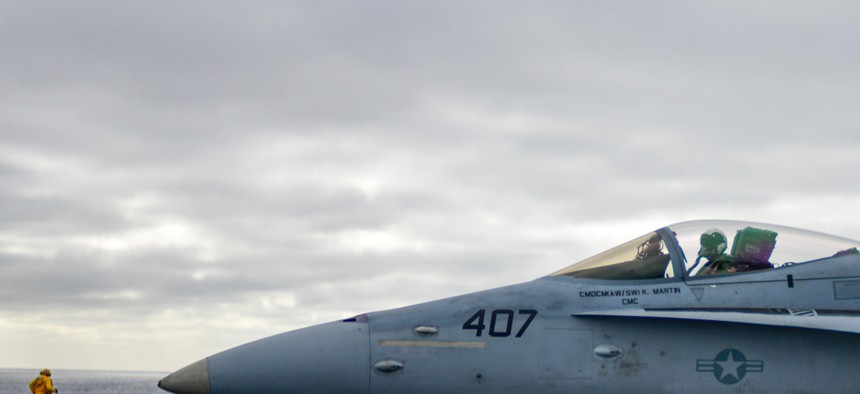
A sailor aboard the USS John C. Stennis direcs an F/A 18 during a training exercise, on December 10, 2014. U.S. Navy photo by Mass Communication Specialist 3rd Class Ignacio D. Perez
7 Defense Issues That Should Be In the State of the Union Address
If history is a guide, the president is likely to look increasingly abroad in the final phase of his last term. Here are 7 defense-related issues to look out for in Tuesday night's address. By Janine Davidson
Although military and defense issues are rarely the most prominent topic for the president’s annual State of the Union Address, many of us will still be listening closely tonight for how President Obama uses those few minutes devoted to national security and foreign affairs. 2014 saw serious setbacks and emerging challenges for U.S. international policy that must be handled. If history is a guide, Obama is also likely to look increasingly abroad in the final phase of his presidency. Here are seven defense-oriented issues I expect the president to acknowledge, and what I hope to hear him say about them:
- Iraq and Syria: This is President Obama’s best opportunity to lay out his long term strategy for the United States’ role in the fight against ISIS and the quest for a more stable region. The president needs to help the American people understand: 1) why this crisis is in America’s interest to address; 2) how exactly American military and diplomatic power are being brought to bear; and 3) what “success” or “victory” looks like in the short, medium, and long term.
- Afghanistan Drawdown: Although the United States ended its Afghanistan combat mission on December 28, the threat of Afghanistan spiraling into violent chaos looms large. ISAF-trained and equipped Afghan security forces face daily attacks from an emboldened Taliban and, most recently, the threat of ISIS spreading into Afghanistanand further radicalizing opponents of President Ashraf Ghani. Given these facts on the ground, tonight would be a good time for the president to either explain why these trends are not going to undermine the progress made to date or otherwise announce that he is reconsidering the planned slope of withdrawal.
- Terrorism: The recent horrific terrorist attacks in Paris and Sydney as well as the foiled attack in Belgium reflect the growing global threat of violent extremism and raise expectations for action. The president might seize the SOTU opportunity to address this challenge and explain how America and our allies will adapt our approaches to both keep our citizens safe and protect our democratic freedoms. A major re-evaluation of our counter-terrorism strategy is overdue.
- Iran: The deadline for reaching an agreement on Iran’s nuclear program has been delayed until June 30 of this year. Members of Congress are growing impatient and skeptical that a positive deal can be made and are threatening to impose automatic sanctions against Iran if a deal is not reached by this next deadline. President Obama will need to make the case for why this diplomatic effort can still bear fruit if he is to convince his critics to give him room to negotiate. Avoiding a nuclear armed Iran is critical to the long-term stability of the region. Doing so diplomatically is exponentially better than the military alternatives.
- Support to NATO: Russian President Vladimir Putin’s year of aggression against Ukraine and continued provocations against the United States and our allies have proven a harsh wake-up call for the NATO alliance. The SOTU is an opportunity for the president to outline the military side of America’s strategy to counter and deter further Russian aggression. This includes both non-lethal and potentially lethal support to Ukraine as well as various military deployments and exercises in support of NATO allies and U.S. leadership in the region.
- Asia Rebalance: As Russia, the Middle East, and the threat of home-grown terrorism made most of the headlines this year, many questioned the health of President Obama’s “Asia Rebalance” policy. The SOTU will be his opportunity to reassure skeptics at home and across Asia that the rebalance is still on track. Expect the emphasis to be (as it should be) on the push for the important Trans-Pacific Partnership economic trade agreement. However, he might also make note of the military sides of the equation: the fact that the Asia-Pacific now houses 55 percent of the U.S. fleet (60 percent by 2020); the growth of robust military-to-military partnerships in the region; or the series of new basing and port access agreements signed with nations like Vietnam or the Philippines in the years since the rebalance was first announced.
- Cybersecurity: Last but certainly not least, expect President Obama to address cyber security as a “cross-over” issue that touches both defense and the domestic economy. The latest attacks against Sony highlight the complexity of the cyber threat and the degree to which both big corporations and everyday Americans are at risk. Expect the president to outline his latest proposal regarding legal changes that will enable more public-private cooperation in defense against cyber attacks.
The Bottom Line: Ultimately, none of the president’s defense and security agenda will work without the support of the 114th Congress. President Obama will likely reiterate that sequestration—automatic, across-the-board spending caps put into place by congressional indecision in 2011—remains a poor deal for both domestic services and the U.S. military’s warfighting ability. Congress has so far failed to put the country back on course toward a sane budgeting practice. Perhaps this year will be different.
This post appears courtesy of CFR.org.
